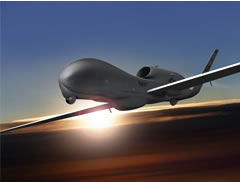Sense and Avoid (SAA) technologies will be an important element in the US Navy Broad Area Maritime Surveillance (BAMS) program, making it safer for the unmanned aircraft to share airspace with piloted aircraft. One of the most challenging requirements for BAMS is “due regard”, the ability to ensure that the unmanned aircraft can operate safely with otheraircraft when outside controlled airspace not under normal flight procedures. Northrop Grumman has been working with the US Government on sense-and-avoid technologies for more than five years.
NGC proposed a low risk solution using an existing radar based ‘due regard’ system as a primary sensor and additional data sources in the mission control system (MCS) to assist the unmanned aircraft pilot on the ground. “The challenge is that once the unmanned aircraft has detected another aircraft as a potential collision threat, the unmanned aircraft pilot has little time to respond” said Carl Johnson, vice president and Northrop Grumman’s BAMS program manager. “You need a fail-safe solution to guarantee avoidance, so we have developed algorithms to assist the pilot in choosing the right maneuver. We’ve found the best way is to combine the features of radar and EO sensors. This EO sensor can generate visual images to provide the equivalent of human sight”. According to Johnson, because radar is more mature, it will be the primary sensor for collision avoidance, but EO sensors will be added to meet sense-and-avoid requirements still being developed by the Federal Aviation Administration.
The baseline BAMS Global Hawk RQ-4N solution includes a pilot-in-the-loop as the cognitive maneuver decision maker using Northrop Grumman’s initial aircraft collision avoidance system (ACAS) algorithm. The ACAS software provides radar and cooperative system contact detection and tracking, which provides a recommended maneuver direction for collision avoidance while maintaining at least 500 feet of separation.
As this process is tested, matures and actions can become autonomous, a Jointly Optimal Collision Avoidance (JOCA) algorithm will be employed on the RQ-4N as it processes conflict resolution decisions. JOCA works with many competing objectives such as following right of way rules, keeping the contact within radar field of view and ensuring there will be no new conflict with nearby traffic to expeditiously maintain separation from potential conflicting traffic. As a result, the unmanned aircraft will be able to generate aggressive maneuvers to avoid close-in contacts without exceeding flight limits.
To verify their approach Northrop Grumman designed a ground laboratory for SAA hardware–in-the-loop testing and evaluation, which will be used to support its BAMS solution.
















